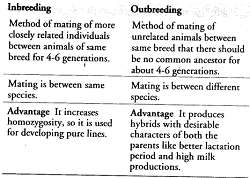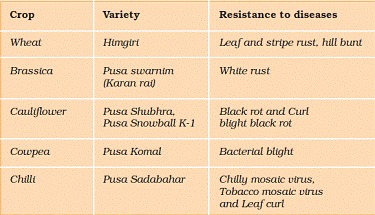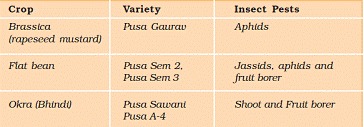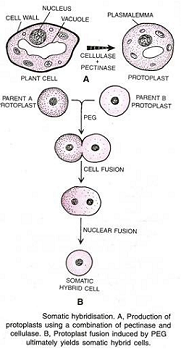Strategies for Enhancement in Food Production class 12 Notes Biology in PDF are available for free download in myCBSEguide mobile app. The best app for CBSE students now provides Strategies for Enhancement in Food Production class 12 Notes latest chapter wise notes for quick preparation of CBSE board exams and school based annual examinations. Class 12 Biology notes on chapter 9 Strategies for Enhancement in Food Production are also available for download in CBSE Guide website.
CBSE Guide Strategies for Enhancement in Food Production class 12 Notes Biology
CBSE guide notes are the comprehensive notes which covers the latest syllabus of CBSE and NCERT. It includes all the topics given in NCERT class 12 Biology textbook. Users can download CBSE guide quick revision notes from myCBSEguide mobile app and my CBSE guide website.
Class 12 Biology notes Chapter 9 Strategies for Enhancement in Food Production
Download CBSE class 12th revision notes for chapter 9 Strategies for Enhancement in Food Production in PDF format for free. Download revision notes for Strategies for Enhancement in Food Production class 12 Notes and score high in exams. These are the Strategies for Enhancement in Food Production class 12 Notes prepared by team of expert teachers. The revision notes help you revise the whole chapter 9 in minutes. Revision notes in exam days is one of the best tips recommended by teachers during exam days.
Download Revision Notes as PDF
CBSE Class 12 Biology Revision Notes Chapter 9 Strategies for Enhancement in Food Production
To fulfil the demand of food items due to increasing population, biological principles are applied in animal husbandry and plant breeding.
Animal husbandry- is the agricultural practice of breeding and raising livestock. Animal husbandry deals with the care and breeding of livestock like buffaloes, cows, pigs, horses, cattle, sheep, camel goat etc. It includes poultry farming and fisheries. Fisheries include rearing, catching, selling, etc., of fish, molluscs (shell-fish) and crustaceans (prawns, crabs, etc.) More than 70% of livestock population of the livestock live in India and China.
Management of Farm and Farm Animals
A professional approach of farm management have increased the food production many folds. Some of the management procedures applied in various livestock are as follows-
Dairy farm management
Dairying is the management of animals for its milk and its product for human consumption. In dairy farm management, we deal with processes and systems that increase yield and improve quality of milk.
- Selection of good breeds having high yielding potential, combined with resistance to diseases is very important.
- Cattle have to be housed well, should have proper water and be maintained disease free.
- The feeding of cattle should be carried out in a scientific manner (quality and quantity of fodder).
- Strict cleanliness and hygiene are importance while milking, storage and transport of the milk and its products.
Poultry Farm Management- poultry is the class of domesticated birds used for food or for their eggs. It mainly includes chicken and ducks and with turkey and geese. Important components of poultry farm management includes-
o Selection of disease free and suitable breeds.
o Proper and safe farm condition.
o Proper feed and water
o Hygiene and health care
Animal Breeding – It aims at increasing yields of animals and improving the desirable qualities of the product. A breed is a group of animals related by descent and similar in most of characters like general appearance, features, size, configuration etc. There are two kinds of breeding
- Inbreeding – breeding between animals of same breeds.
- Outbreeding- crosses between different breeds.

Inbreeding depression – continued inbreeding reduces fertility and even productivity. This is called Inbreeding Depression. Whenever this becomes a problem, selected animals of the breeding population should be mated with unrelated superior animals of the same breed. This usually helps restore fertility and yield.

Out-breeding is the breeding of unrelated animals, which may be between individuals of same breed but, having no common ancestors or between different breeds (cross breeding) or different species (interspecific hybridisation).
Out-crossing- this is the practice of mating of animals within the same breed but having no common ancestors on either side of their pedigree up to 4-6 generation. The offspring are called out-cross.
Cross breeding- superior male of one breed are mated with superior female of another females of another breed. Cross breeding allows the desirable qualities of two breeds to be combined.
Interspecific hybridisation- male and female animals of two different species are mated. The progeny may combine desirable features of both and parents. Ex- mule.
Controlled breeding experiments are carried out using artificial insemination. The semen is collected from the male that is chosen as a parent and injected into the reproductive tract of the selected female by the breeder.
Multiple Ovulation Embryo Transfer Technology (MOET) is used to increase the success rate of artificial insemination. In this method, a cow is administrated hormones (FSH) to induce follicular maturation and super ovulation, instead of one egg; they produce 6-8 eggs. The fertilised eggs 8-32 cells stages, are recovered non-surgically and transferred to surrogate mothers.The genetic mother is available for another round of super ovulation.
Bee-keeping : Bee-keeping or apiculture is the maintenance of hives of honeybees for the production of honey. Honey is a food of high nutritive value and also finds use in the indigenous systems of medicine. It also produces beeswax.
The most common species of honey bee is Apis indica. The following points are important for successful bee-keeping-
- Knowledge of the nature and habits of bees
- Selection of suitable location for keeping the beehives
- Catching and hiving of swarms
- Management of beehives during different seasons
- Handling and collection of honey and of beeswax.
- Keeping beehives in crop fields during flowering period increases pollination efficiency and improves the yield.
Fisheries : Fishery is an industry devoted to catching, processing or selling of fish, shellfish or other aquatic animals.
Fresh water fishes which are very common include catla, rohu and common carp. Common marine fishes are Hilsa, sardines, mackerel and pomfrets.
Different techniques have been applied to increase production like aquaculture and pisciculture. Blue Revolution is implemented to increase fish production.
| Pisciculture | Aquaculture |
| It is a process of growing fish and selling it or using its products for domestic or commercial use. Fish can be grown both in salt water or fresh water. | It is a process of growing any aquatic animals and selling them for commercial purposes. It involves feeding, harvesting and many other processes. The most popular one’s grown under controlled environments are shrimps,crab,fish,lobster and few others. |
Plant Breeding is the purposeful manipulation of plant species in order to create desired plant species in order to create desired plant types that are better suited for cultivation, give better yields and are disease resistant.
Classical plant breeding involves crossing or hybridisation of pure lines, followed by artificial selection to produce plants with desirable traits of higher yield, nutrition and resistance to disease.
The main steps in plant breeding are-
a) Collection of variability is the collection and preservation of all the different wild varities, species and relatives of the cultivated species. The entire collection having all the diverse alleles for all genes in a given crop is called germplasm collection.
b) Evaluation and selection of parents is the identification of plants with desirable combination of characters. The selected plants are multiplied and used in the process of hybridisation.
c) Cross hybridisation among the selected parents to obtained desired crop characters for example high protein quality of one parent may need to be combined with disease resistance from another parent. This is possible by cross hybridising the two parents to produce hybrids that genetically combine the desired characters in one plant
d) Selection and testing of superior recombinants -The selection process is crucial to the success of the breeding objective and requires careful scientific evaluation of the progeny. This step yields plants that are superior to both of the parents
e) Testing, releasing and commercialisation of new cultivars -The newly selected lines are evaluated for their yield and other agronomic traits of quality, disease resistance, etc.
Wheat and Rice : Production of wheat and rice increased tremendously between 1960-2000 due to introduction of semi-dwarf varieties of rice and wheat.
- In 1963, several varieties such as Sonalika and Kalyan Sona, which were high yielding and disease resistant were introduced all over the wheat growing field of India.
- Semi-dwarf rice varieties were derived from IR-8, and Taichung Native-1 were introduced in 1966. Later better-yielding semi-dwarf varieties Jaya and Ratna were developed in India.
Sugar cane
- Saccharum barberi and Saccharum officinarum were crossed to get the desirable qualities of high yield, thick stems, high sugar and ability to grow in the sugar cane areas of north India.
Millets
Hybrid maize, jowar and bajraare developed in India. These varieties are high yielding and resistant to water stress.
Plant Breeding for Disease Resistance
Several fungal, bacterial and viral pathogens affect the yield and quality of plant products. To minimise this loss disease resistant varieties were developed. Breeding is carried out by conventional method or by mutation breeding.
Steps for breeding disease resistant plants:
- Selection of genome with disease resistant traits
- Mating of the selected parents
- Selection of superior hybrids
- Testing of the hybrid for superior variety
- Release of the new variety
Some crop varieties bred by hybridisation and selection for disease resistance to fungi, bacterial and viral disease are released-

Mutation is the process by which genetic variations are created through changes in the base sequence within genes resulting in the creation of a new character or trait not found in the parental types. It is done by using mutants like chemicals or radiations. This process is called mutation breeding. e.g
- Mung bean resistance to yellow mosaic virus and powdery mildew were induced by mutation.
- Resistance to yellow mosaic virus in bhindi (Abelmoschus esculentus) was transferred from a wild species and resulted in a new variety of A. esculentus called Parbhani kranti.
Plant breeding for Developing Resistance to Insect Pests
Crop plant and crop products are destructed by insects and pests on large scale. To prevent this loss new varieties resistance to them are developed.
Steps for breeding disease resistant plants:
- Selection of genome with disease resistant traits
- Mating of the selected parents
- Selection of superior hybrids
- Testing of the hybrid for superior variety
- Release of the new variety

Bio-fortification-Breeding crops with higher levels of vitamins and minerals, or higher protein and healthier fats. Breeding for improved nutritional qualities have following objectives of improving
· Protein content and quality.
· Oil content and quality
· Vitamin content
· Micronutrient and mineral content
Atlas 66, having a high protein content, has been used as a donor for improving cultivated wheat.
IARI, New Delhi have released many varities of vegitables crops rich in vitamnis and minerals like vitamin A enriched corrot, spinacch and pumpkin and vitaminC enriched bitter guard, bathua, mustard ,iron and calcium enriched spinach and bathua; and protein enriched beans – broad, lablab, French and garden peas.
Single Cell Protien (SCP)– alternate source of protien for animal and human nutrition. Microbes are grown on industrial scale as a source of good protien.
- Microbes like spirullina can be grown easily on materials like waste water from potato processing plants having strach, molasses, animal manure and even sewage to produce large quantities and can serve as food rich in protien, minerals, fats, carbohydrates and vitamins.
- Methylophilus methylotrophus has high rate of biomass production and growth,it can be expected to produce 25 tonnes of protein by 250 g of microorganism.
Tissue Culture
The capacity to generate whole plants form any cell/explant is called totipotency. Thousands of plants can be produced from expalnts in short interval of time using suitable nutrient medium, aseptic condition and use of phytohormones. This method of producing thousands of plant is called micropropagation.Each of these plants will be genetically identical to the original plant from which they were grown, i.e., they are somaclones. Many important food plants like tomato, banana, apple.
Meristem Culture – the recovery of healthy plants from diseased plants can be done by mersitem culture .Although the plant is infected with a virus, the meristem (apical and axillary) is free of virus. Hence, one can remove the meristem and grow it in vitro to obtain virus-free plants
Somatic Hybridisation
Isolation of single cells from their plants and after digesting their cell wall fusing the cytoplasms of two differnet varieties is called somatic hybridisation and these hybrids are called somatic hybrids

CBSE Class 12 Revision Notes and Key Points
Strategies for Enhancement in Food Production class 12 Notes Biology. CBSE quick revision note for class-12 Chemistry Physics Math’s, Biology and other subject are very helpful to revise the whole syllabus during exam days. The revision notes covers all important formulas and concepts given in the chapter. Even if you wish to have an overview of a chapter, quick revision notes are here to do if for you. These notes will certainly save your time during stressful exam days.
- Physics
- Chemistry
- Mathematics
- Biology
- Accountancy
- Economics
- Business Studies
- Computer Science
- Informatics Practices
- English Core
- History
- Physical Education
To download Strategies for Enhancement in Food Production class 12 Notes Biology, sample paper for class 12 Physics, Chemistry, Biology, History, Political Science, Economics, Geography, Computer Science, Home Science, Accountancy, Business Studies and Home Science; do check myCBSEguide app or website. myCBSEguide provides sample papers with solution, test papers for chapter-wise practice, NCERT Strategies for Enhancement in Food Production, NCERT Exemplar Strategies for Enhancement in Food Production, quick revision notes for ready reference, CBSE guess papers and CBSE important question papers. Sample Paper all are made available through the best app for CBSE students and myCBSEguide website.
- Reproduction in Organisms class 12 Notes Biology
- Sexual Reproduction in Flowering Plants class 12 Notes Biology
- Human Reproduction class 12 Notes Biology
- Reproductive Health class 12 Notes Biology
- Principles of Inheritance and Variation class 12 Notes Biology
- Molecular Basis of Inheritance class 12 Notes Biology
- Evolution class 12 Notes Biology
- Human Health and Disease class 12 Notes Biology
- Microbes in Human Welfare class 12 Notes Biology
- Biotechnology Principles and Processes class 12 Notes Biology
- Biotechnology and its Applications class 12 Notes Biology
- Organisms and Populations class 12 Notes Biology
- Ecosystem class 12 Notes Biology
- Biodiversity and Conservation class 12 Notes Biology
- Environmental Issues class 12 Notes Biology

Test Generator
Create question paper PDF and online tests with your own name & logo in minutes.
Create Now
Learn8 App
Practice unlimited questions for Entrance tests & government job exams at ₹99 only
Install Now